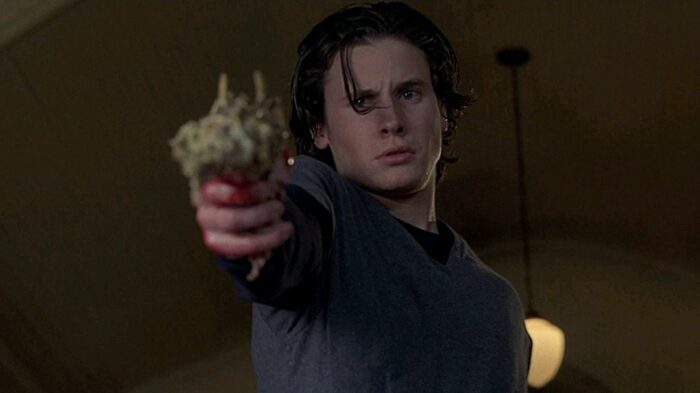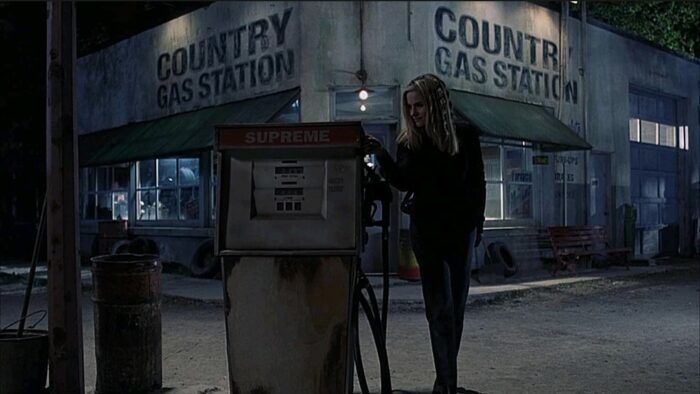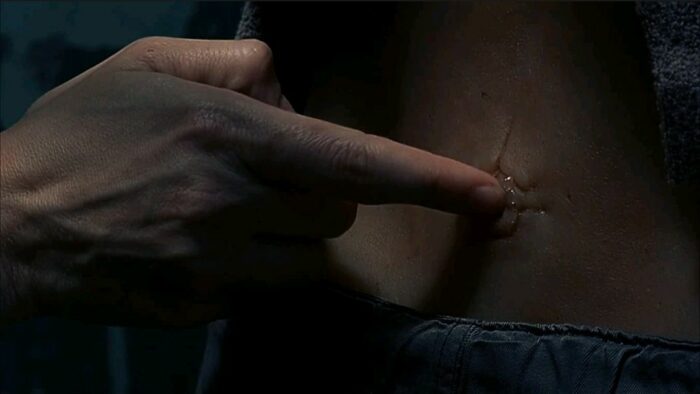There is perhaps no living director associated with the dread combination of the human physique and its deformation than David Cronenberg. Whether it’s a zombie-like outbreak caused by an experimental medical procedure in Rabid (1977) or the melting and degradation of a human/fly hybrid through teleportation in The Fly (1986), themes of scientific breakthroughs causing people to act or become less human is an important through-line in his early filmography. However, in his techno-thriller film eXistenZ (1999), Cronenberg anticipates a world of virtual reality gaming and corporate espionage that would become more prevalent in the real world and even become major themes for David Cronenberg’s son Brandon Cronenberg in his breakout film Possessor (2020). Through the use of disgusting technology, complicated corporate plots, and the confusion between virtual reality and real-life, David Cronenberg created one of the most forward-thinking sci-fi films of the 1990s.

None of the gore and disgusting visuals are related to the human body like in Cronenberg’s previous films; instead, the disgusting visuals are shifted into the various sci-fi creations within the film. Within the world of eXistenZ (1999), people connect to the titular virtual creation through fleshy pods and connection cables that resemble umbilical cords. While most sci-fi films of the 1990s like Johnny Mneomic (1995) and The Matrix (1999) utilized somewhat contemporary designs of computers for their dystopian future settings, Cronenberg instead abstracts the design of the technologies within eXistenZ from what would be conceivable in a real-world setting. Their fleshy texture and uneven rounded designs makes the technologies, and therefore the virtual world of the film that results from it, seem less human and otherworldly.
Moreover, the apprehension felt by the film’s audience towards these technologies is supported by the main character Ted Pikul (Jude Law), who works as an audience surrogate through his inexperience with the pods. Pikul is reluctant to install bio ports to hook the fleshy wires from the pod into his body to connect to the virtual world within the film, making the technologies seem unappealing to the common person.
Another highlight of the visually unappealing technology is the bone gun used by the realist fanatic Noel Dichter (Kris Lemche) to shoot Allegra Geller (Jennifer Jason Leigh) and is later crafted by Ted Pikul in a simulated restaurant. The organic design of the bone gun is naturally nauseating due to its jagged exterior that looks as uncomfortable to wield as it is to put together as seen by Jude Law’s character utilizing various bone parts from an unappetizing meal to craft the gun together. Also, the origins and components of the gun further strengthen the feelings of disgust an audience member would feel towards the weapon as it utilizes teeth for bullets, shifting away from the clean and sterile parts that weapons use in favor of parts of organic and DNA material that makes it naturally unclean.

Along with these sequences of disgusting technological creations, the overall plot of eXistenZ utilizes various subplots of corporate espionage, anti-technology extremism, and confusion between the virtual and real world. Cronenberg intrigues the audience with a surprise assassination attempt at the start of the film as the technology magnate Allegra Gellar is suddenly shot. The attempted assassin is supposed fan Noel Dichter, a “realist” that aims to kill people like Allegra for the alleged corruption of reality with her brand-new virtual world technology creation. This moment is a great introduction to the paranoid atmosphere of the rest of the film, as the two main characters of Ted and Allegra are on the run from the radical anti-technology faction and rival companies, making any introduction of new characters a potential threat. Furthermore, the assassination attempt serves a great expository purpose by showing the importance of Jennifer Jason Leigh’s character; it shows her influence and power due to the assassin trying to stop her further rise to power, highlighting her as a central point of interest in the film to revolve around without having Ted explain it for the audience.
Not only is there the threat of anti-technology radicals, the film employs aspects of corporate espionage. Other technology companies try to steal or damage the prototype virtual reality technology that the main characters use throughout the film, including Yevgeny Nourish (Don McKellar), a supposed Realist contact who is revealed to be a Cortical Systematics double agent. The aspects of hidden identities alongside the blurred boundaries between the virtual world and the real world that the main characters sometimes experience further compound the complexity of the science fiction concept. The audience is confused by factors both related and unrelated to the virtual reality technology, making everything as seemingly dubious as the virtual world the main characters find themselves in. This confusion between friendly allies and hidden foes is further amplified by Jude Law’s character, who is as much of an outsider to the world of shadowy corporate tactics as the film’s audience, making him highly relatable as an audience stand-in.

While most of the film revolves around the main characters trying to survive their hunters, both Ted and other characters question if they’re in a virtual world or not due to the actions they partake in. When Ted assembles the bone parts from the specialty meal in the restaurant and aims the bone gun at the waiter, he feels the urge to kill the man out of nowhere. This moment of unnecessary violence from the normally restrained Ted draws a sense of worry about whether or not he’s losing control over his actions due to the game nature of the film or if he has enough agency to decide to shoot the man, giving rise to worries if the main characters are controlled by the technology they use or not. Also, this moment raises doubts between nature of action versus control because Ted knows to assemble, load, and use the weapon with no previous knowledge on how the weapon is made or works, further allowing the audience to question if Ted as is as clueless to the complicated nature of the film’s world as he’s presented to be during the first part of the film.
Moreover, the film raises further questions as Ted and Allegra are revealed to have been playing characters in a virtual game throughout the film and shoot the actual game designer before aiming their guns at the person that played the waiter in the simulated restaurant, who questions if they’re still in a game before the film cuts to black. This final scene adds another layer of depth to the nature of the real versus virtual world because the characters the audience have followed throughout the film are suddenly revealed to be the true radicals of the film, when most of the running time has been spent following them on the run from the same radicals and trying to protect the prototype virtual reality technology. Whereas the characters were confident that they were in the real world at the start of the film, the waiter character asking if they’re still in a game leaves the audience and characters on an existential question of anyone being able to truly tell the difference between artificiality and reality.

While David Cronenberg used the genre conventions of science fiction to bring anxiety towards still-distant technologies within The Fly (1986), eXistenZ (1999) is much more relevant because the virtual reality technologies within the film are present in the contemporary world and will become even more advanced in the years to come. With the rise of additional technology companies and games as distractions, the possibilities can be endless. However, what will be the distinction between real and virtual worlds when the boundaries of technology are broken and expanded upon?



